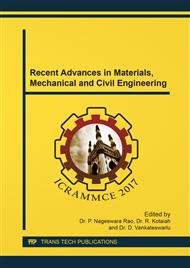[1]
V. A. Romanova, R. R. Balokhonov, S. Schmauder, Numerical study of mesoscale surface roughening in aluminum poly crystals under tension, Materials Science and Engineering: A. 564 (2013) 255-263.
DOI: 10.1016/j.msea.2012.12.004
Google Scholar
[2]
D. Fabre, C. Bonnet, J. Rech, T. Mabrouki, Optimization of surface roughness in broaching, CIRP Journal of Manufacturing Science and Technology (in press).
DOI: 10.1016/j.cirpj.2016.10.006
Google Scholar
[3]
S. Mukherjee, A. Kamal, K. Kumar, Optimization of material removal rate during turning of SAE 1020 material in CNC lathe using Taguchi technique, Procedia Engineering. 97(2014) 29-35.
DOI: 10.1016/j.proeng.2014.12.221
Google Scholar
[4]
D. Karayel, Prediction and control of surface roughness in CNC lathe using artificial neural network, Journal of materials processing technology. 209: 7 (2009) 3125-3137.
DOI: 10.1016/j.jmatprotec.2008.07.023
Google Scholar
[5]
G. Alagarsamy, M. Kathiresan, K. Vinukumar, Optimization of cutting parameters on surface quality in CNC machining, International Journal of Engineering & Science Research. 5: 6 (2015) 449-460.
Google Scholar
[6]
Q. Meng, J. A. Arsecularatne, P. Mathew, Calculation of optimum cutting conditions for turning operations using a machining theory. International Journal of Machine Tools and Manufacture. 40: 12 (2000) 1709-1733.
DOI: 10.1016/s0890-6955(00)00026-2
Google Scholar
[7]
I. Asiltürk, S. Neşeli, M. A. Ince, Optimisation of parameters affecting surface roughness of Co28Cr6Mo medical material during CNC lathe machining by using the Taguchi and RSM methods, Measurement. 78 (2016) 120-128.
DOI: 10.1016/j.measurement.2015.09.052
Google Scholar
[8]
Q. Yi, C. Li, Y. Tang, X. Chen, Multi-objective parameter optimization of CNC machining for low carbon manufacturing, Journal of Cleaner Production. 95(2015) 256-264.
DOI: 10.1016/j.jclepro.2015.02.076
Google Scholar
[9]
G. H. Gowd, M. V. Goud, K. D. Theja, M. G. Reddy, Optimal Selection Of Machining Parameters In CNC Turning Process Of EN-31 Using Intelligent Hybrid Decision Making Tools, Procedia Engineering. 97 (2014) 125-133.
DOI: 10.1016/j.proeng.2014.12.233
Google Scholar
[10]
R. D. J. Johnson, K. L. D. Wins, A. Raj, B. A. Beatrice, Optimization of Cutting Parameters and Fluid Application Parameters during Turning of OHNS Steel, Procedia Engineering. 97 (2014) 172-177.
DOI: 10.1016/j.proeng.2014.12.239
Google Scholar
[11]
P. Suresh, K. Marimuthu, S. Ranganathan, T. Rajmohan, Optimization of machining parameters in turning of Al-SiC-Gr hybrid metal matrix composites using grey-fuzzy algorithm, Transactions of Nonferrous Metals Society of China. 24: 9(2014).
DOI: 10.1016/s1003-6326(14)63412-9
Google Scholar
[12]
N. Prabhakar, B. Sreenivasulu, U. Nagaraju, Application of ANOVA and ANN Technique for Optimize Of CNC Machining Parameters, International Journal Of Innovations In Engineering Research And Technology. 1: 1(2014) 1-12.
Google Scholar
[13]
N. K. Sahu, A. K. Sahu, A. K. Sahu, Optimization of weld bead geometry of MS plate (Grade: IS 2062) in the context of welding: a comparative analysis of GRA and PCA–Taguchi approaches, Indian Academy of Sciences. 8: 3(2017) 234–259.
DOI: 10.1007/s12046-016-0589-1
Google Scholar
[14]
R. Sutar, Multi Objective Optimization of Cutting Parameters in Turning Operation Using Taguchi Method, E-thesis, National Institute of Technology, Rourkela (2014).
Google Scholar
[15]
A. J. Makadia, J. I. Nanavatiof, Optimisation of machining parameters for turning operations based on response surface methodology, Measurement. 46: 4 (2013) 1521-1529.
DOI: 10.1016/j.measurement.2012.11.026
Google Scholar


